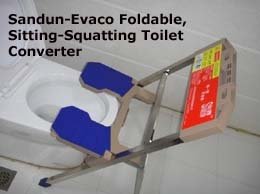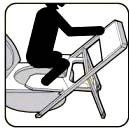|
Sexual Dysfunction - Hitting Men and Women Where It Hurts The Most...
You might wonder why this site includes a section on sexual dysfunction, a complex health issue with many possible causes. SIDENOTE A recent US study has revealed that more than half of the population -- 52% of men and 63% of women -- could be suffering from it.
The high incidence of sexual problems can be attributed to the widespread use of sitting toilets. In the sections on pelvic-related ailments (Pelvic Floor Prolapse, Urinary Incontinence and Prostate Problems), you can read why a person using a sitting toilet has to strain for bowel movements.
It is this straining, while holding the breath, and pushing downwards with the diaphragm (the Valsalva Maneuver) that causes the pelvic floor to be pressed downwards repeatedly. The pelvic floor is simply not designed to cope with this kind of abuse. Over time, the pelvic floor, weakened by the repetitive stress, gives way and descends. With the descent of the pelvic floor, the pudendal nerve, which passes through the pelvic floor and carries signals between the brain and pelvic and sexual organs, could suffer from stretch injury. Injury of the pudendal nerve can lead to serious consequences: urinary incontinence, prostate dysfunction, chronic pelvic pain, and yes, sexual dysfunction. A recent article in the American Journal of Obstetrics and Gynecology described the connection between the pudendal nerve and female sexual dysfunction...
If they had known about straining on the sitting toilet, they wouldn't have called described the "pudendal nerve - sexual dysfunction link" an enigma. Although the research study had only involved women, a man's pelvic floor is also vulnerable. Pudendal nerve damage is a major cause of male sexual dysfunction as well (and prostate trouble). The pudendal nerve can slowly be restored when it is no longer subjected to daily abuse. But only if the underlying cause -- repeated straining on sitting toilets -- is removed. A restored pudendal nerve would reinstate the flow of signals between the brain and sexual organs, and provide a good chance of regaining normal sexual function. It can be difficult to accept this at first...that sitting toilets could affect the sexual health and happiness of men and women. But recall what Yale research team have discovered about the link between the pudendal nerve and sexual dysfunction:
(More information about the pudendal nerve.)
For sitting toilets are too entrenched for the world to abandon it now. As a result, in spite of the benefits of squatting, it will be an uphill task to convince everyone to change their toileting posture from sitting to squatting. Many won't have a choice as they don't have squat toilets at home. Those who have been using sitting toilets their entire lives may see the need to squat, but would find squatting to be a difficult posture, as explained on this page about squatting facets.
But there is no other way but to squat. To protect against sexual dysfunction, one must regain the ability to squat and then find a way to switch from sitting to squatting for bowel movements. What's the best way to do this? Install a
squatting toilet.

You can find out more about Nature Knows Best by visiting this page.
Additional Reading Squat Toilets -- Where In The World Can You Still Find Them?
Have A Great Story About This Topic?Do you have a personal account about the topic discussed on this page? Please consider sharing it. You can be sure that many people in the world would love to read about and greatly benefit from your experience. It's easy to do. Just let your words flow. Thanks for sharing! What Other Visitors Have SaidClick below to see contributions from other visitors to this page...
Sitting to Squatting Toilet Converter - A Great Invention
|
The Best Toilet Converter in The World Today!


Helping People All Over
The World Achieve
Good Health Through
Correct Toileting Posture
Watch video on the
origin and story of
the Sandun-Evaco
toilet converter
All about Life,
Hope and Truth...
FREE:
One of the most
astounding books
you will ever read
in your life!












